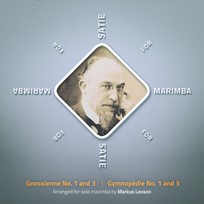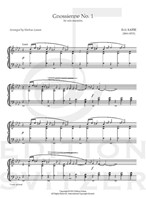
Satie
Composer: Erik Satie / arr. Markus Leoson
Instrument: Marimba
Level: Intermediate/Advanced
Published: 2021
Price: €20.00
Item details
-
Description +
-
Preface
Gymnopédie 1 and 3 together with Gnossienne 1 and 3 are of course very well-known pieces but anyhow so suitable for the marimba since the original was written for piano. I´ve deliberately tried to stay as close to the original as possible but made it more appropriate to play for the marimbist according to the instruments range and technical possibilities.
Please feel free to experiment with different kind of rolls like the ripple-roll, the one-hand-roll and the more unknown Ada-roll. Remember that turning the body just a little to the right or to the left facilitates many tricky tremolo suggestions. Several tremolos are also optional. The way to execute some of the more difficult tremolos (especially the Ada-roll) will I explain in a coming video at www.editionsvitzer.com
These four pieces by Erik Satie are my own favourites where the composer´s mind and mood together with his cunning musical poetical expression suits the spiritual essence of the marimba like hand in glove.
Index
Gymnopédie 1 and 3
Gnossienne 1 and 3
-
-
Instrumentation +
-
Solo Marimba (5 octave)
-
-
About the composer +
-
Éric Alfred Leslie Satie (17 May 1866 – 1 July 1925), who signed his name Erik Satie after 1884, was a French composer and pianist. Satie was an influential artist in the late 19th- and early 20th-century Parisian avant-garde. His work was a precursor to later artistic movements such as minimalism, repetitive music, and the Theatre of the Absurd.
-
-
Reviews +
-
Review (Percussive Notes, October 2021)
This is a collection of four piano pieces by French composer and pianist Erik Satie, arranged for marimba. Contained in this collection are: “Gymnopédie 1,” “Gymnopédie 3,” “Gnossienne 1,” and “Gnossienne 3.” While “Gymnopédie 1” has been arranged in many different ways for percussion instruments (solo and ensemble), there are not as many arrangements of the “Gnossienne” pieces. The arranger states that he deliberately stayed as close as possible to the original piano compositions, with only slight alterations made to accommodate the range of the marimba.
Each arrangement lasts between three and five minutes and could be played as a standalone work, rather than being combined to form a suite. Performers will appreciate the fact that the emotion of the music will have to be drawn out through Satie’s effective chord progressions and utilization of subtle note changes, as opposed to complicated marimba permutations and fourmallet athleticism to get the musical point across to audience members.
One area to address is the marimba’s inability to sustain as long as a piano. With the original pieces, Satie’s melodic and harmonic presentationis anchored on the ability to lengthen musical ideas through a piano’s sustain pedal. The best alternative for a marimbist is to incorporate onehanded rolls, which might be a challenge for many percussionists. Additionally, there might have to be alterations to the original tempo and feel of the works, to avoid any disconnect in musical lines when managing the short sustain of a strike on a marimba bar.
These works could make a great addition to a performer’s repertoire, primarily based on the high quality of the source material. Satie wrote gorgeously expressive music that is worthy of pursuit on any musician’s performance radar.
—Joshua D. Smith
-
-
Credits +
-
Front Cover graphics and layout: Ronni Kot Wenzell
Photo: © Artave
Engraving: Johan Svitzer
Printed in Copenhagen, Denmark
Copyright © Edition SVITZER
www.editionsvitzer.com
-



